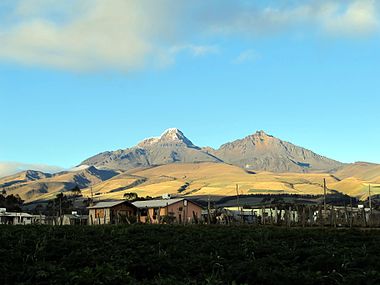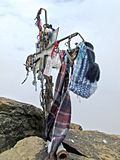
The Illinois is an extinct stratovolcano with a distinctive double peak (Iliniza Sur, 5,248 m and Illinois Norte, 5,126 m), the mountain is about 55 kilometers south of Quito in the Sierra of Ecuador.
Regions
| location | ||
| Data | ||
| height | 5,248 m | |
|---|---|---|
| Provinces | Cotopaxi, Pichincha | |
The northeast quarter of Iliniza is in the Pichincha Province, the other three quarters are in the Cotopaxi Province. The border runs across both peaks.
places
The next valley location with an infrastructure suitable as a base is El Chaupi.
The next bigger ones Valley locations at the Panamericana are Latacunga, Machachi and the smaller towns of Santa Rita and Santa Ana del Pedregal.
background
The information on the summit heights varies somewhat in the sources, for the rocky and slightly lower northern summit heights of 5116 to 5126 m are given, for the glaciated southern summit values for the height from 5,248 m to 5,263 m the highest peaks in Ecuador are numbers six and eight.
The current twin peak is, two kilometers apart, the rest of the former volcano, the actual and even higher peak of which was probably blown away in a huge explosion. The volcano is considered to have been extinct for a long time.
The southern summit is glaciated, but the ice on the mountain is badly affected by the retreat of the glaciers. The north summit is an ice-free rocky summit.
A derivative of the Called will be on "Illan" and "isha" in the language of the Colorados, an indigenous people of the region, where "Illan" means man and "isha" means us.
The double summit is also called Illinois (South summit) and Tioniza (Northern summit), meaning man and woman. According to a legend, the southern summit is the enchanted lover of a local beauty, turned into stone by a magician at the instigation of the father of the wooed beauty: The father had completely different plans for his daughter's future. The daughter was then also turned to stone by the same wizard and at her own request and to the north summit near her lover.
First ascent

The first ascent of the Illinois is a continuation of the legendary duel of the first ascent on Matterhorn:
Also Edward Whymper, First to climb the Matterhorn (1865) and the neighboring one Chimborazo (1880), first tried on Illinois Sur: he failed in his two climbing attempts.
The First to climb the south summit were then in 1880 the two brothers brothers Jean and Louis Carrel.
In the prehistory on the Matterhorn was Jean-Antoine Carrel First ascent on the more difficult Italian Liongrat and second only a few days behind Whymper at the summit. In a time without a phone and after breaking an agreement, Whymper had climbed across the Hörnligrat from the simpler Swiss side with Swiss companions decisive days beforehand in good weather conditions to try again with Carell.
The Illinois Norte has a special meaning for active mountaineers in Ecuador: it is the only one of the five thousand meter peaks in the country that was first climbed by local mountaineers. On May 3, 1912, the leader Nicolas G. Martinez reached the summit of the Illinois Norte with Franz Hiti and Alejandro Villavicencio.
Illinois National Park

The protected area, officially called "Reserva Ecologica Los Illinois", was designated in 1996 and has an area of 149,900 hectares, it is distributed between the two provinces of Cotopaxi and Pichincha and ranges from heights of 800 m to 5,248 m (Illinois Sur).

Among other things also belongs to the Laguna Quilotoa and the volcano Corazón with to the nature reserve. Important rivers are the Toachi, the Río Zarapullo and Esmeraldas, which have their source regions in the reserve.
The national park does not yet have a particularly developed tourist infrastructure, the entrance fee is $ 5;
getting there
The large-scale journey to Illinois takes place from the east to the mountain and over the Panamericana with branch approx. 7 kilometers south of Machachi (Quisinche) to the west and over the village El Chaupi.
From El Chaupi, the road becomes increasingly a driveway and even "worse" (dirt road): because of the volcanic ash subsoil, the track is extremely badly washed out in various places (deep gullies) and can only be passed by vehicles with good all-terrain capabilities . The highest accessible point is the parking lot La Virgen (approx. 4,200 m), see "Refugio Nuevos Horizontes" in the section accommodation.
Tourist Attractions

- Laguna Verde. The picturesque green mountain lake lies between the two peaks and a little northwest of the saddle at an altitude of around 4,690 m (0 ° 39 ′ 24 ″ S.78 ° 43 '14 "W.).
- On the approach route there is at the village El Chaupi a hill with a view and a small ruin from the Inca era.
activities
Ascent
Adequate altitude adjustment is essential before climbing the Illinois, you should have stayed in the Sierra for a few days and have reached altitudes of up to 4,500 m without any problems. General remarks on Height adjustmenthere.
Ascent to the hut at the connecting saddle see at Refugio following.
Since a serious mountain accident on October 21, 2012 on the Illinois Sur (dragging accident) and with three fatally injured local mountaineers, the volcanic mountains of Ecuador with heights of over 5,000 m have only been allowed to be climbed in the company of licensed mountain guides since the end of 2012.
On the day of the tragic accident, a Sunday, a group organized by the Club de Andinismo Politécnico (CAP) was on the way, including seven experienced climbers from the club.The southern summit was reached by five people, who in two groups on the normal route and on the more difficult Celso Zuquillo Route had climbed. The accident then happened on the descent, where the front group of three mountaineers fell fatally on steep terrain.
Climbing the Illinois Norte


The actual summit ascent to the north summit (0 ° 38 ′ 58 ″ S.78 ° 43 '14 "W.) starts with the Nuevos Horizontes Refuge at the connecting saddle and is a popular acclimatization tour for even higher peaks.
From Sattel, the route initially leads for the longest part directly on the rocky south-east ridge with a few climbing points to below the Pico Villavicencio pre-summit. From there the ascent crosses the steep but not difficult north-east flank ("Paso de la Muerte", death pass) and to below the north-east ridge, which runs through a short and steep gully (45 ° approx. 20 mH, helmet due to rockfall from loose rubble! ) is achieved. On the northeast ridge it is then a short stretch in the rocks with some not too difficult climbing spots to the summit.
At the summit, if the weather conditions are right, there is a wide view all around and, as an exception on the high mountains of Ecuador, there is also a small summit cross.

The descent is identical to the foot of the gully, but from there the northeast flank (steep in the upper part, up to approx. 30 °, rubble and scree) is climbed directly further down, the crossing back to the southeast ridge is omitted.
The ascent route is exposed in parts from the south-east ridge, a rope is definitely recommended for the ascent in the gully, and for the less experienced also for the short climbing sections on the two ridge sections. The endangerment comes mainly from the rubble and loose volcanic rubble: the trail is "little cleared", it is absolutely necessary to walk carefully.

Climbing tracks are clearly visible to varying degrees on sandy subsoil, but are very difficult to see in the rocky sections. As a rule, the ascent is ice-free, but snow with a hidden track cannot be ruled out, depending on the weather and the time of year. The ascent time from the hut to the north summit is approx. Three to four hours.
With appropriate planning with arrival and start at the parking lot in the dark, the tour is well possible as a day tour, otherwise with an overnight stay in Refugio Nuevos Horizontes.
Ascent to Illinois Sur
The ascent of the south summit (0 ° 39 ′ 44 ″ S.78 ° 42 ′ 58 ″ W.) is a demanding ice tour (ZS) in steep (up to 70 °) and exposed terrain.
The glacier ice on Illinois Sur is heavily affected by the glacier retreat from global warming, the ascent routes are increasingly objectively unsafe because they are severely affected by ice and rock falls, so they change constantly over the course of the year.
The currently common ascent routes as normal routes lead through the northwest flank to the summit. The normal route is the westernmost one with the longest section of the glacier and the fewest climbing parts, but an ice break zone ("Crevasse"), the "La Rampa" is the direct and steepest ascent. Another and even more difficult route is the one over the east ridge ("Celso Zuquillo Route").
kitchen
There is no way to get provisions on the mountain.
accommodation


The hut is made of masonry, it has a thick roof and around a dozen beds inside as a mattress store. There is also a kitchenette. There is no running water or fuel, but there is water in a stream nearby. Occasionally the hut is visited by a warden.
The highest point that can be approached La Virgen (approx. 4,200 m, 0 ° 37 ′ 48 ″ S.78 ° 41 ′ 20 ″ W.) before the ascent to the hut, take the approach road west of El Chaupi and also depends on the condition of the road and the skill of the driver:

At the end of the partly extremely curvy and in parts strongly rinsed road there is a parking lot with signs and the official entrance to the reserve and without any further infrastructure (no kiosk or the like).

Costs for the journey with a Camionetta e.g. out Machachi around twenty dollars.
The further ascent to the hut then takes place on mountain paths in a slightly marshy landscape in the lower part and still with shrub growth and small trees, in the upper part there is increasingly low heather vegetation and volcanic debris. Ascent time to the hut about three hours. For the route from El Chaupi with over 10 kilometers to the parking lot, you should also plan at least one hour.
Camping possibility is available at the parking lot La Virgen (Water in a stream) and at the hut.
climate
For general information on the climate, see also the article on Sierra.
The Illinois is a year-round travel destination, but the best months to visit are the drier months from July / August to December, with the summer months around August being the driest season. The rainy season lasts from January to May / June.
Around September there can be a kind of Indian summer with the "Veranillo" as a stable phase of good weather and with heavy precipitation beforehand, but from September onwards, winter with precipitation and, depending on the altitude, also as snow are possible.
During periods of bad weather, fog and precipitation must be expected from midday at the latest, whereby the precipitation can also fall as snow, depending on the altitude. The possible restricted view from fog should be taken into account when planning the tour.
The following applies to the ascent: Temperatures and zero degrees at the summit and strong winds are always possible all year round, adequate wind protection (xxx-Tex) is absolutely recommended.
literature
- : Mountain guide Ecuador. Panico-Alpinverlag, 2009, ISBN 978-3926807823 , Pp. 252-257; 298 pages. 29.80 €, all volcanoes and mountains of Ecuador of mountaineering interest
- : Ecuador: A Climbing Guide. Mountaineers Books, 2000, ISBN 978-0898867299 , Pp. 74-83; 189 pages (English).. Not completely out of date and at least somewhat up-to-date for the glacier-free peaks.




